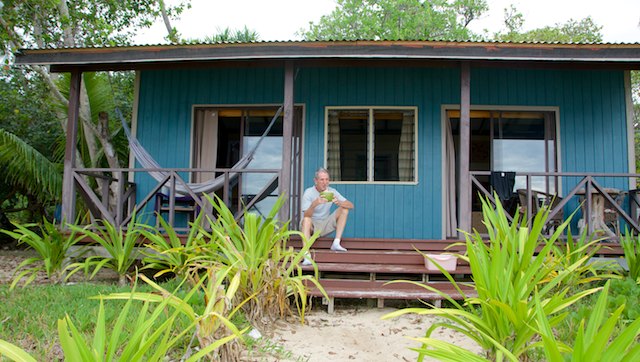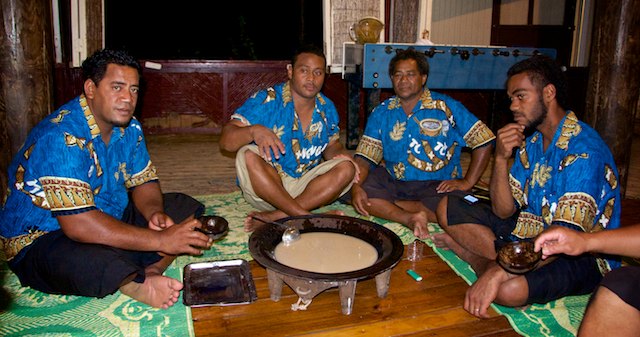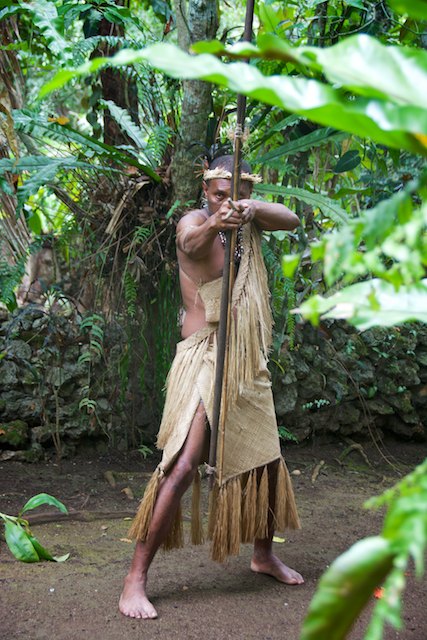Dateline: Atata, a tiny little island about a half hour’s boat ride from the main island of Tonga.
Thanks to the new fiber optics line laid down courtesy of Fiji in August, we have pretty (erratic but), excellent wee fee. Considering. So here we are, sitting in a bar at 9 am with a group of exuberant Rugby fans. Tonga is in the world cup today against The Cook Islands. This is weird. We could be in any sports bar anywhere in any place in the whole wide world. World travelers can tell you, sports fanaticism is universal. Only there’s no drinking here. The only alcohol consumption this entire week at the Royal Sunset Resort will be completely our responsibility. It’s a tough job but somebody’s got to do it and we will make every effort to “get ‘er done” in true American fashion.
As of this moment Tonga leads 14-10…make that 18-10. You heard it here. The Cook Islands? (Pussies.) Although the word for that in Tongan escapes me.
These guys are some serious rugby fans. Did I already say that?
You have to forgive me because I did NOT stay on the wagon. Fell off the kava wagon last night. I now know: kava messes with my short-term memory. Big. Time. Which reminds me. I forgot to record my serious error regarding the use (and abuse?) of kava. Correction: Kava is NOT consumed exclusively by the citizens of Vanuatu. No. No. No. Fijians are also BIG consumers of the stuff. And, now we know, they brew it here on Tonga, too.
Kava, it turns out, is very popular all over the South Pacific.
Back to how I fell from grace:
Last night when we arrived here on Atata we were surprised to find that we are the ONLY guests on the entire island. Population of Atata is 300. Last night the census rocketed upon our arrival to 302. Pretty amazing. So, we (by default) get the VIP fale (room) which has everything you might need, but is maybe one or two steps up in accommodation niceties from a great back packer hotel. No stars.
The upside is that our front deck is literally ten feet from the lapping Pacific. Facing west. Imagine the view past several lazily moored fishing boats as the sun sets. Words cannot describe it.
Anyway, when our boat pulled up to the resort’s dock, our greeter, Danny, met us and told us that we are the King and Queen because there will be no other guests until Friday. So, whatever we want…
That first night, five guys (unbelievable musicians) came over from the main island to serenade the king and queen (and, whoa!) conduct a kava ceremony in our honor. How could I say no? (Probably the first time in 30 years I yielded to peer pressure.) I woke up around 3 and decided that it would be a very good idea to take a Cipro. I feel fine today. No worries. (I’ve been carrying those emergency Cipro around for years and I finally needed one. Thank-you, Doctor Horton for the script because I’m pretty sure that if I hadn’t had them in my ready possession I would even now be in my fale on my knees wishing I was dead instead of enjoying the game here in the bar with my mates.) I learned my lesson: No. More. Kava. For the queen. This time I mean it. (Note: not sure if it was the kava. Might have been the veggies at dinner. I didn’t drink the water and even boiled the water I used to brush my teeth in, so ????) Meanwhile, the boys in the band drank (literally) a bucket of kava before turning in. They giggle like middle school kids when you ask them questions about kava so I guess they are all addicted to the stuff. (Women on Tonga, unless you are a tourist, don’t partake.)
But they do get to watch the game. In fact the girls are in the front row and seem to be loudly enjoying the game every bit as much (more) as the guys. Like certain Packers fans I know – minus the cheese heads. (No names, but you girls know who you are up there at Pattie’s on 70 in lovely Winter, Wisconsin).
The other distinction regarding kava consumption between the island nations is the ceremony itself. On Vanuata, as previously reported, a kava party bears strong resemblance to a frat party during Spring Rush. Here on Atata in Tonga, the process is more like a pot party. Everybody is MELL-LOW. VERY, VERY MELL-LOW. They sit in a circle on hand woven mats (you can guess who does the weaving of those puppies) and a participant will clap their hands once if they want a “hit”. Then the guy with the ladle, (who seems to have some kind of authority, maybe he brewed the batch???) pours a coconut shell full of kava and passes it over. The kava is slugged down in silence and the coconut shell gets passed reverentially back to the guy with the ladel.
Then a short, quiet conversation occurs, presumably about the next audio selection, and one of three guitars starts up. They are lovely singers and the harmonies are beautiful. Pablo got a description of the lyrics and it had something to do with some guy who wants a divorce but he either can’t afford it or for some other undeclared reason he can’t acquire one so he’s stuck with a wife he doesn’t love. (Tongan Country Western.) Lightweights, we hit the sack after two cups. The band played on and finished the bucket. (We were informed this morning.) It’s a rule. Nobody leaves until the kava is finished. (Except for the tourists who get a kava pass.)
Next up, when the rugby game concludes on the tube, we will enjoy a village tour and the mandatory tour of the elementary school. (This will be our third such tour and so far my preliminary observations of public schools in the tropics leads me to believe that the kids seem to be enjoying endless recess. Not a lot of book learnin’ going on but plenty of P.E. Maybe why Tonga is right this minute destroying the Cook Islands.) Go Tonga!
















